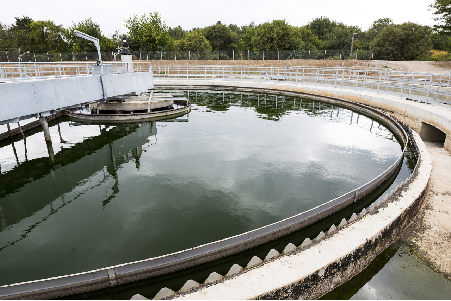Wastewater treatment:
A method of purifying wastewater by separating pollutants or converting pollutants into harmless substances.

I. Physical treatment
Physical treatment:
A method of separating and removing insoluble suspended pollutants (including oil films and oil beads) in wastewater by physical effects.
1. Gravity separation treatment:
Its processing units include sedimentation, flotation (air flotation), etc. The processing equipment contains sedimentation chamber, grit chamber, oil separation tank, air flotation tank and its ancillary devices, etc.
2. Centrifugal separation treatment:
Is a processing unit, and the equipment contains centrifugal separators, hydrocyclone separators, etc.
3. Sieve interception treatment:
Has two processing units: screen interception and filtration. The former uses grids and screens, and the other uses sand filters, microporous filters, etc.
4. Other treatment:
Wastewater evaporation treatment, wastewater gas-liquid exchange treatment method, wastewater high gradient magnetic separation treatment method, wastewater adsorption treatment method, etc.
Advantages:
Most equipments is easily operated and has good separation effect, so it is widely used.
II. Chemical treatment
Chemical treatment:
Separating and removing dissolved or colloidal pollutants in wastewater or convert them into harmless substances by chemical reactions and mass transfer.
1. Chemical reactions by adding chemicals:
Coagulation, neutralization, redox, etc.
2. Based on mass transfer:
Extraction, stripping, stripping, adsorption, ion exchange, electroosmosis and reverse osmosis, etc.
3. Other treatment:
Neutralization, coagulation, chemical precipitation, oxidation, extraction, etc.
Advantages:
This method can more quickly and effectively remove more pollutants than biological treatment, and can be used as a tertiary treatment measure after biological treatment. It also has the advantages of easily operated equipments, easy automatic detection and control, and easy recycling. Chemical treatment can effectively remove a variety of highly toxic and highly toxic pollutants from wastewater.
III. Physicochemical treatment
Physicochemical treatment:
Using combined action of physics and chemistry to purify wastewater.
1. Wastewater treatment system consisting of physical and chemical methods:
Chemical coagulation - two-stage treatment of sedimentation and activated carbon adsorption for the removal of suspended and dissolved pollutants.
2. Including individual treatment methods of physical processes and chemical processes:
Such as flotation, air stripping, crystallization, adsorption, extraction, electrolysis, electrodialysis, ion exchange, reverse osmosis, etc.
Advantages:
Compared with the biological treatmentd, this one has the following advantages: less area, good and stabl effluent quality, strong adaptability of changes in wastewater's volume, temperature, and concentration, removing harmful heavy metal ions, phosphorus removal, nice denitrification, and decolorization effects, easy operations of automatically detect and control, etc.
Disadvantages:
The costs of equipment and daily operation for treatment system are expensive.
IV. Physicochemical treatment
Biological treatment:
Also known as "wastewater biochemical treatment", referred to as "wastewater biochemical method", using the metabolic action of microorganisms to convert dissolved and colloidal organic pollutants in wastewater into harmless substances for purification.
1. Aerobic biological treatment:
Activated sludge method, biofilm method, oxidation pond method, sewage irrigation, etc.
1) Activated sludge process: a kind of treatment with multiple operating modes.
2) Biofilm method: the equipment includes biological filters, biological turntables, biological contact oxidation, biological fluidized beds, etc.
2. Anaerobic biological treatment:
Also known as biological reduction treatment, is mainly used to treat high-concentration organic wastewater and sludge. Its equipment is mainly digesters.
V. Biochemical treatment
Biochemical treatment:
Ion exchange method, a wastewater treatment that converts organic pollutants in solution, colloid and finely suspended states in wastewater into stable and harmless substances through the metabolism of microorganisms.
1. Aerobic biological treatment:
Using aerobic microorganisms (including facultative microorganisms) to perform biological metabolism in the presence of oxygen to degrade organic matter and make it stable and harmless. Microorganisms use the organic pollutants present in the water as substrates to perform aerobic metabolism. After a series of biochemical reactions, they release energy step by step and are finally stabilized as low-energy inorganic substances to achieve harmless requirements in order to return to the natural environment or further processing.
2. Anaerobic biological treatment:
An organic wastewater treatment which using facultative anaerobic bacteria and obligate anaerobic bacteria to degrade macromolecular organic matter in sewage into low molecular compounds and then convert it into methane and carbon dioxide. It is divided into two stages of acid digestion and alkaline digestion. During the acidic digestion stage, exogenous enzymes secreted by acid-producing bacteria transform macromolecular organic matter into simple organic acids, alcohols, aldehydes, ammonia, carbon dioxide, etc. In the alkaline digestion stage, the metabolites of acidic digestion are further decomposed into biogas composed of methane, carbon dioxide, etc. This treatment method is mainly used for high-concentration organic wastewater and fecal sewage.
If you think this information infringes upon your legitimate rights and interests, please send relevant qualification certificates and requirements to info@v-cheersfilters.com, and the website staff will respond as soon as possible!
08-31
202507-31
202506-30
202505-31
202505-15
2025